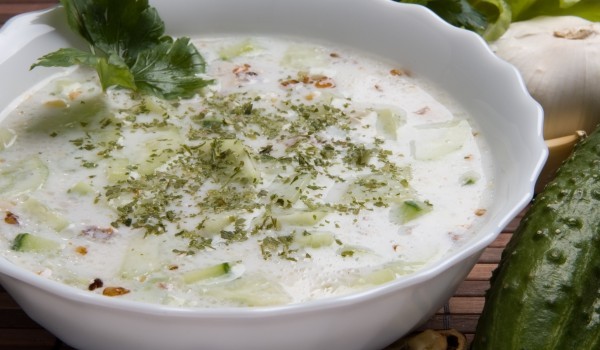In the Balkans, we have many things in common that both unite and separate us at the same time. Our national cuisines are one of the reasons to argue and they have even provoked political contradictions. This is because we can discuss recipes with passion and excitement anywhere, anytime, on the phone, in the street, in the shop... Like everything subjective, the perception of the palate becomes the subject of passionate strife for us. Whether to use a specific vegetable or not, what spice is more suitable, who invented a recipe and who has the right to distribute it as a national dish and emblem of the state.
I remember when I was a little boy that my grandfather told me that lyutenitsa, which I love so much, was not a Bulgarian but Greek dish. And it was not only that, as there were differences between Greek and Bulgarian lyutenitsa. The Greek one was with cheese and the Bulgarian was not because we, Bulgarians, were poorer at that time and could not afford to put cheese in it. I do not know if this is true or not, but then it was not hard to believe him. In the years of "mature socialism”, the shelves were empty like a box of fine chocolates during a banquet.
I decided to conduct a piece of research and found some interesting facts about our Balkan cuisines to share with you.
The moussaka war

There is hardly anyone who does not like moussaka and who can resist the sight of a warm and delicious serving of this dish. Of course, we, Bulgarians, consider it our traditional dish. However, it turns out that it is known far beyond Bulgaria.
Different countries know this delicious dish under different names. The Greeks call it μουσακάς, Romanians musaca, Turks musakka, and in Armenian, it is Մուսակա. Probably more Balkan countries also prepare this dish with passion and eat it with appetite. Moreover, if you ask them, they are all convinced that moussaka is their invention.
In Bulgaria, moussaka became popular only after it permanently entered the Greek and Turkish cuisine. Greeks are those who have made the dish popular throughout the world. Therefore, Greek moussaka is considered authentic and its original recipe is with eggplants instead of with potatoes.
Greek moussaka is comprised of layers of fried eggplant slices, tomato sauce and minced meat, usually beef or mutton, and béchamel sauce is poured over it, together with some sprinkled cheese. Some popular variations of Greek moussaka use Parmesan, Gruyere or kefalotiri and breadcrumbs. I guess there are other variations of this recipe, one of which, namely Greek moussaka, we have offered to you as well.
When a Romanian, Serbian or Bulgarian hears moussaka, he immediately thinks of that familiar dish of sliced potatoes and minced meat. In Bulgaria the emphasis, when preparing moussaka, remains on minced meat and potatoes that you steam with spices and then subsequently bake in the oven. Finally, add a sauce prepared with eggs, yogurt and flour and bake the dish until it is done. Quite often, traditional Bulgarian moussaka is served with yogurt.
In Turkey, they most often serve moussaka along with Turkish tarator known as dzhadzhik and pilaf.
Versions of moussaka with zucchini, carrots and other vegetables have appeared over the years and there are numerous vegetarian variations of this dish too.
We see that the dish is popular and has many individual variations in different countries as well as in different areas of each country. Moussaka has long left the geographical boundaries and restaurants worldwide serve it to their customers.
So, who invented moussaka? It is a traditional Arabic dish. Even its name is taken from the Arabic "musaqqaʿa", which literally means cooled down. Arabs however consider moussaka something they like to call cooked salad. In the Middle East, moussaka is most often prepared with tomatoes and eggplants, and is usually served cooled, as an appetizer.
That is the Balkan style: we can argue about something that is not even ours.
Tarator for the soul

Tarator is another dish that we consider Bulgarian but it has entered the country through Greece. It can also give rise to culinary wars, as not only these two countries have claims for its invention. The situation in this case is more complicated. Cucumber was cultivated 3000 years ago in India and other parts of Asia and was brought to Europe during the wars of Alexander of Macedonia. It quickly became popular in Egypt, Rome and Greece, not only because of its nutritional properties but also because of its medicinal and cosmetic properties. Who first mixed cucumber and yogurt will remain a mystery to us. Tarator can be found not only in the Balkans but also in Iran, where it is called "mast o khiar", which means "yogurt and cucumber." Tarator is often considered as a cold salad or as a refreshing summer dish.
Greeks prepare tzatziki - a salad the main ingredients of which are cucumber, yogurt, garlic and olive oil. In Bulgaria, this salad has a poetic name, namely "Snow White".
Turkish dzhadzhak is similar to Bulgarian tarator, but instead of fennel, they add mint to it whereas tarator is a creamy sauce of ground walnuts and garlic, which is used as an addition to vegetables, fish or shellfish. The original version of tarator is prepared with hazelnuts, but often they are replaced by walnuts or almonds.

Tarator goes very well with mastika ... I will not start on this topic since the spirits will rise very high with Greek "Ouzo", French "Pernod", "Ricard", "Pastis", Spanish "Anisado", Italian "Sambuca", Turkish "Yeni Raki" (corresponding more to Bulgarian rakia).
Balkan kyopolou

Although we are not inclined to admit it, the fact is that some of the dishes that we take for national pride have come to us from Greece. This has its historical reasons and explanations. To the dishes previously mentioned, we should add Easter bread and drob-sarma (a dish of diced liver, rice and herbs). As for white brined cheese, we will not utter a word because lumps of feta will start flying along before we know it.

It is another issue that many of these dishes have Turkish influence, but this will surely provoke a dispute. Here we can include hotchpotch, kyopolou, kapama, kavarma, baklava and many more. We will only mention shopska salad as it will also provoke a dispute, this time with our Serb neighbours all the way to the Turkish chuban salad. White, green, red, the three colours and all that they symbolize, combined in a dish, best accompanied by a small, fiery appetizer, which will also provoke us to argue as to who has invented it. Yes, but the neighbours say that Shopi were actually Serbs assimilated by Bulgarians and therefore, shopska salad actually is Serbian salad. No matter that it is not prepared in the same way – the pepper is raw and often spicy, the tomatoes and cucumbers are chopped, there is no cheese at all.

Kebapche is also a dividing territory and if we flatten it out, the matter will take the form of meat patties. No matter how strange it may seem to us, they also grill kebapche in Romania, but there they add a strong flavouring of garlic and prefer minced beef. However, Serbian kebapche, again a "national" creation, will really give you a shock. They call them "chepavi", they are not bigger than the little finger of a man's hand and are served 10-15 in number, usually spiced.
The Slavic origin of the Bulgarians is represented by a wide variety of bakery products that definitely out-rival our neighbours as they include banitsa (cheese pastry), tutmanik (cheese cake), pancakes, tiganitsi, katmi (patties), donuts, mekitsi (batter fried in deep oil), flat breads and round loaves. Well, some of them we can find with the neighbours ... Gyuzlemi and Arabic bread which is used for gyros and souvlaki. We will let the neighbours brawl about them, without intervening.
What about lyutenitsa?

Honestly, I could not find Greek lyutenitsa with cheese. Maybe there is. Maybe my grandfather was impressed by what he saw at the time. We will not fight about lyutenitsa. It is a new dish and the ingredients for it, namely tomatoes and peppers, appeared in the region only in the 18th - 19th century. Although most Balkan peoples know some variation of this cooked mixture of ground pepper and tomato, lyutenitsa remains true typical Bulgarian culinary knowledge. In terms of lyutenitsa Bulgarians have shown remarkable cultural flexibility by being able to turn something strange into their own. Well, it turns out that we have created "the Bulgarian version of" each of these dishes, in the good sense.
In conclusion, I would say that the dishes we put on the table should bring us together and unite us rather than divide us. We are so much alike and the same in so many ways that our differences should only be the cause for the exchange of experience and knowledge rather than for strife, as well as for celebration, as we all know how to do it. Cheers!